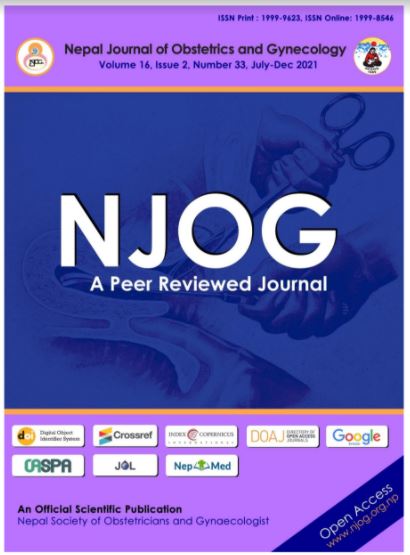Obstetric outcome in patients with rheumatic heart disease: experience in a tertiary hospital
Keywords:
cardiac disease, maternal mortality, pregnancy, RHDAbstract
Aims: To determine the clinical outcome of rheumatic heart disease in pregnancy.
Methods: Retrospective cross-sectional descriptive study from April 2019 to April 2021 in Nobel Medical College, Biratnagar, Nepal. Feto-maternal variables were taken for their health status. Data presented in table with frequency.
Results: Out of 13013 deliveries in a year, 49 had cardiac disease (0.37%) and 38 had rheumatic heart disease (0.29%) over 28 weeks of gestation; 95% (n=36) had mitral valve involvement; 12 were primigravida and 7 preterm at the time of delivery. Half of them underwent caesarean section for various indications. Most common maternal complications were cardiac failure, cardiac arrythmia, admission to ICU, obstetric complications, including maternal mortality in 5.2% (n=2) cases. Low birth was in 29% (n=11) of cases, and 34% (n=13) of them needed NICU care at the time of delivery. There was history of rheumatic fever in 9 cases (24%).
Conclusions: Rheumatic heart disease is the commonest diagnosis among heart disease in pregnancy and adverse event can be minimized by multidisciplinary intervention
Downloads
Downloads
Published
How to Cite
Issue
Section
License
Copyright (c) 2022 Amar Nath Chaudhary, Gehanath Baral, Shanti Subedi, Sita Ghimire, Rakina Bhansakarya

This work is licensed under a Creative Commons Attribution-NonCommercial 4.0 International License.
Copyright on any research article in the Nepal Journal of Obstetrics and Gynaecology is retained by the author(s).
The authors grant the Nepal Journal of Obstetrics and Gynaecology a license to publish the article and identify itself as the original publisher.
Articles in the Nepal Journal of Obstetrics and Gynaecology are Open Access articles published under the Creative Commons CC BY-NC License (https://creativecommons.org/licenses/by-nc/4.0/)
This license permits use, distribution and reproduction in any medium, provided the original work is properly cited, and it is not used for commercial purposes.



